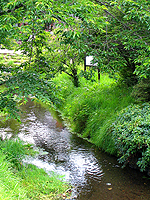
1. Monitoring and Prediction of the Water Cycle Variability
3. Understanding River Ecology from the Standpoint of Engineering
 |
1. Monitoring and Prediction of the Water Cycle Variability 3. Understanding River Ecology from the Standpoint of Engineering |
|---|

In river management, recovery of healthy rivers with their rich biomass and biodiversity is even a more difficult and challenging issue than flood control or water utilization. One of the reasons for this problem is that the goals of river health recovery are difficult to quantify. Historically, research topics about various riverine plants and animals and their interactions have been studied only within the field of ecology. However habitats are formed through the processes of nature like flooding, therefore, for a deeper understanding of the whole river ecosystem it is essential to study hydraulics, geomorphology and their interaction from an engineering standpoint. Studying the river ecosystem from the standpoint of engineering is called 'environmental river engineering', something that we are aiming to establish. Following this approach, we sometimes see our research target from a quite different point of view then that taken by ecologists. Our research aim is to clarify the mechanism of how current ecosystem conditions are formed by integrating habitat evaluations from an engineering perspective, with those of the existing ecosystem evaluations arrived at from an ecological perspective. The clarification of this mechanism will contribute to future river management measures; hopefully resulting in more rivers starting to gradually recover their ecological integrity and even begin to meet the demands of flood control and water utilization. This concept is what underlies our current research works.
'Riffles' and 'pools' are essential factors of a river and its ecosystem. Although the importance of the riffle-pool structure has been recognized for a long time, issues like 'what kind of riffles and pools are evaluated as good?' and 'how are such riffles and pools formed' have not been sufficiently discussed or studied. Further, what type of riverbed morphology is formed as the result of the workings of nature and the impact of humans?, and what meaning does it have for the biota? We are working on answers to these kinds of questions.
When you watch a river, you can focus on its various properties. On a large scale, we generally take the whole river basin or the catchment area as a unit and consider the geological characteristics, land use etc.. Such an approach to rivers (with a basin-wide scale or larger) is being undertaken by the hydrology group in our laboratory. As well, we are now also concerned with the hierarchical structure at smaller scales in river systems; a segment scale (upstream, downstream), at the Riffle-Pool scale, a the scale of different biotop types or at the scale of each gravel type. Each member of our group is studying a different scale and analyzing and evaluating river environments hierarchically.
We put emphasis on field observation and periodically perform observations such as geomorphological surveys and hydraulic measurements at our various observation sites. In respect to biological samplings and analyzes, our group does not have enough experience or skill; so we constantly undertake cooperative research with ecologists such as fish, benthic insect, and algae researchers. We discuss with and learn from them. Deskwork is also a necessity of research activities, but we believe that we can discover many things through repeated field trips and observations. We also aim to observe rivers from many other points of view through working cooperatively with other researchers.